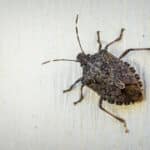While termites are the most well-known wood-boring pests, they aren’t the only ones that can become unwelcome guests in your home. Carpenter ants are common across the United States and can cause significant structural damage to residential homes. Here’s everything you should know about carpenter ants to prevent an infestation in your home.
What are Carpenter Ants?
There are hundreds of species of carpenter ants, but the black carpenter ant is the most common in the US. In fact, they are the largest species of ants in the US, with workers that can be up to half an inch long and swarmers that are even larger. Carpenter ants will typically be all black, and swarmers have translucent wings while worker ants are wingless.
Carpenter ants get their name from how they make their homes, called galleries. Carpenter ant galleries are long tunnels carved in wood from which the worker ants will forage for food as the queen nests inside to lay her eggs. Carpenter ant galleries look similar to the tunnels that termites create, except that the walls of carpenter ant tunnels are smooth rather than rough.
What are the Signs of Carpenter Ants?
Since carpenter ants are uncharacteristically large for their kind, many homeowners first notice the presence of carpenter ants when they see the ants themselves. However, even if you haven’t seen any carpenter ants, there may be other subtle signs that these pests are building a nest inside your home.
Unlike termites, carpenter ants don’t ingest wood as they burrow through it. Instead, they chew the wood into sawdust and remove it from their burrows. This leaves a mixture of sawdust and ant parts, called frass, near the exits of carpenter ant galleries. You may see frass around wooden baseboards, door jams, or window sills in your home.
Carpenter ants prefer to nest in moist or rotting wood rather than dry wood, as it is easier for them to burrow through. The most common places for carpenter ants to invade are around the base of your home where the wood frame meets the foundation. They can also invade outdoor structures like wooden decks or sheds.
How Can You Prevent a Carpenter Ant Infestation?
Like any other pest, getting rid of carpenter ant attractors in your home will reduce the chances of an infestation. Carpenter ants thrive on proteins and sugars, so clean up any spills in your kitchen as soon as possible and avoid leaving pet food on the floor overnight. Carpenter ants also need a source of moisture, so you should get rid of standing water in and around your home and ensure your plumbing is leak-free.
You should always tend to the outside of your home to keep carpenter ants away as well. Overhanging branches that touch your roof and fallen branches around your home’s foundation can provide a bridge for carpenter ants to access your home easily. Cracks in your foundation and worn weatherstripping around doors and windows can provide entry points for carpenter ants.
Moist wood is by far the biggest attractor for carpenter ants. You should avoid storing lumber or firewood near the perimeter of your home and seal your deck regularly to prevent rot that could draw carpenter ants. Stumps that are left behind in your yard can also become the perfect place for a carpenter ant colony as they rot.
The behavior of carpenter ants is well-understood, and taking steps to make your home less attractive to these pests will greatly reduce the risk of structural damage to your home’s frame. If you are dealing with carpenter ants or any other pests, contact Diam Pest Control so we can help you enjoy a pest-free home!





